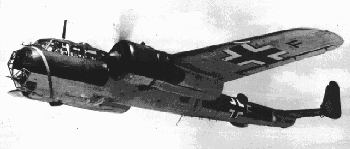The DORNIER Do 17 two motor bombers
have been used by the German Air Force more than any other type for the
numerous photographic reconnaissance flights over France and over Great
Britain. The Do 215, developed from the Do 17, is identical with it except
for a redesigned nose, some strengthening of the structure and the installation
of more powerful motors. The Do 17 was one of the first modern types of
aeroplane to go into production for the Luftwaffe in 1935. Since then it
has been fitted with three different types of motor. The prototype Do 17
flew with 660 h.p. B.M.W. VI un-supercharged liquid cooled upright Vee motors
in the Summer of 1936. It had a top speed of 400 km.h. (249 mph.) at sea
level. Later the 880 h.p, B.M.W. cylinder supercharged air-cooled radials
were installed. They raised the top speed to 445 km.h. (276 m.p.h.) at
3,000 m. (9,840 ft.). Next the Do 17 was built with 1,050 h.p. Daimler
Benz DB.600G motors. With them the top speed went up to 470 km.h. (292
m.p.h.) at 14,800 ft. Basically both the Do 17 and the Do 215 are all metal
high wing cantilever monoplanes . There are twin fins and rudders
at the ends of the cantilever tail plane just outboard of the centre-lines
of the motors.
The original long tapered nose
gained the Do 17 the name of the "Flying Pencil."
The whole machine is flush riveted.
There is no dihedral on the wings,
but the whole of the taper in thickness is on the under surface, The fuselage
is a metal monocoque with stressed skin covering. The full cantilever tail
plane is set at a small dihedral angle. Trimming tabs are used on all the
movable control surfaces. The elevators are mass balanced with external
balances, which pass through slots in the tail plane. The twin rudders
have aerodynamic as well as mass balances. The fixed surfaces have metal
covering, the movable surfaces fabric. The undercarriage is retracted hydraulically.
The wheels, mounted between two oleo legs and equipped with mudguards and
brakes, are raised backwards in to the motor nacelles and enclosed by hinged
doors, so that only the tyre is left protruding. The tail wheel retracts
vertically in to the fuselage.
The Do 17 carries a crew of three,
all in front of the wing. The pilot sits on the port side of the fuselage,
so that there is room for the bomb-aimer to pass to his prone position
below. A navigation compartment with hinged chart table occupies the space
between the back of the pilot and the front spar of the wing.
Forward armament consists of two
fixed machine guns in the front cowling, operated by the pilot. The bombs
are stowed horizontally in the centre section of the fuselage between the
spars. Up to 1,000 kg. (2,205 lb.) can be carried internally. The Do 215
is built on the same jigs as the Do 17 and only varies from it in minor
detail.
They were robust enough to endure terrible amounts of
gunfire, especially small calibre gunfire. Their strength did not depend
upon bracing wires and wooden spars: these metal bombers had armour protection,
with some of the vital mechanical parts duplicated. Even more valuable
were the self sealing fuel tanks. |

